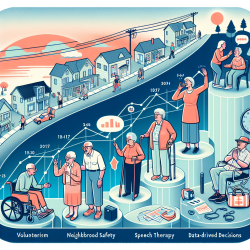Introduction
In recent years, the understanding of Autism Spectrum Disorder (ASD) has expanded significantly, thanks to groundbreaking research. One such study, titled "Subtly altered topological asymmetry of brain structural covariance networks in autism spectrum disorder across 43 datasets from the ENIGMA consortium," provides new insights into the structural asymmetries in the brains of individuals with ASD. This research has profound implications for practitioners, especially those involved in speech-language pathology and child development.
The Study's Findings
The study analyzed brain data from 1455 individuals with ASD and 1560 controls across 43 datasets. The researchers found significant alterations in the asymmetry of brain networks, particularly in regions associated with executive functions, language, and sensorimotor processes. The fusiform, rostral middle frontal, and medial orbitofrontal cortices were notably affected, showing higher randomization of right-hemispheric networks in ASD.
Implications for Practitioners
These findings suggest that altered brain asymmetries could be linked to the behavioral characteristics of ASD, such as language delays and social interaction challenges. For practitioners, this means that therapy approaches could be tailored to address these specific asymmetries. Here are some ways practitioners can leverage these insights:
- Personalized Therapy: By understanding the specific brain regions affected in each child, therapists can design personalized interventions that target these areas, potentially improving outcomes.
- Focus on Executive Functions: Since the study highlights disruptions in networks associated with executive functions, therapies that enhance cognitive control and working memory might be particularly beneficial.
- Interdisciplinary Collaboration: Collaborating with neurologists and psychologists can provide a more comprehensive understanding of each child's unique neurodevelopmental profile, leading to more effective interventions.
Encouraging Further Research
While this study provides valuable insights, it also opens the door to further research. Practitioners are encouraged to explore the following areas:
- Longitudinal Studies: Investigating how these brain asymmetries develop over time could reveal critical periods for intervention.
- Multi-modal Approaches: Combining structural and functional imaging techniques could offer a more holistic view of brain connectivity in ASD.
- Behavioral Correlations: Examining how these structural changes correlate with specific behavioral traits could refine therapeutic strategies.
Conclusion
The subtle alterations in brain asymmetry in individuals with ASD, as highlighted by this study, provide a new perspective on the disorder. By integrating these findings into therapeutic practices, practitioners can enhance their interventions and potentially improve outcomes for children with ASD. As we continue to unravel the complexities of the brain, the potential for innovative and effective therapies grows.
To read the original research paper, please follow this link: Subtly altered topological asymmetry of brain structural covariance networks in autism spectrum disorder across 43 datasets from the ENIGMA consortium.










